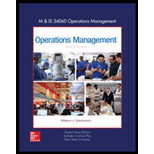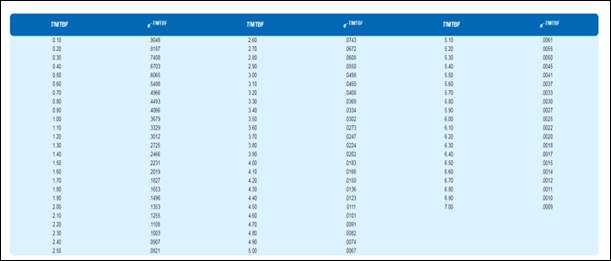
An electronic chess game has a useful life that is exponential with a mean of 30 month. Determine each of the following:
a. The probability that any given unit will operate for at least (1) 39 months. (2) 48 men the (3) 60 months.
b. The probability that any given unit will fail sooner than (1) 33 months. (2) 15 months. (3) 6 months.
c. The length of service tune after which the percentage of tilled units will approximately equal (1) 50 percent, (2) 85 percent, (3) 95 percent, (4) 99 percent.
a)
To determine: The probability the unit will operate at least for the following times.
Introduction:
Mean time between failures (MTBF):
The mean time between failures is a term which denotes the time that is elapsed between the first failure of a product and the second failure of a product. It is calculated during the normal system operation.
Answer to Problem 12P
1) 39 months = 0.2725
2) 48 months = 0.2019
3) 60 months = 0.1353
Explanation of Solution
Given information:
MTBF = 30 months
Formula to calculate the probability of no failure before a time period:
Calculation of probability:
1) 39 months:
Hence, the probability the unit will operate at least for the 39 months is 0.2725.
2) 48 months:
Hence, the probability the unit will operate at least for the 48 months is 0.2019.
3) 60 months:
Hence, the probability the unit will operate at least for the 60 months is 0.1353.
b)
To determine: The probability the unit will fail before the following times.
Introduction:
Mean time between failures (MTBF):
The mean time between failures is a term which denotes the time that is elapsed between the first failure of a product and the second failure of a product. It is calculated during the normal system operation.
Answer to Problem 12P
1) 33 months = 0.6671
2) 15 months = 0.3935
3) 6 months = 0.1813
Explanation of Solution
Given information:
MTBF = 30 months
Formula to calculate the probability of failure before a time period:
Calculation of probability:
1) 33 months:
Hence, the probability the unit will fail before 33 months is 0.6671.
2) 15 months:
Hence, the probability the unit will fail before 15 months is 0.3935.
3) 6 months:
Hence, the probability the unit will fail before 6 months is 0.1813.
c)
To determine: The length of service time for the percentage of failed units.
Introduction:
Mean time between failures (MTBF):
The mean time between failures is a term which denotes the time that is elapsed between the first failure of a product and the second failure of a product. It is calculated during the normal system operation.
Answer to Problem 12P
1) 50 percent = 21 months.
2) 85 percent = 57 months.
3) 95 percent = 90 months.
4) 99 percent = 138 months.
Explanation of Solution
Given information:
MTBF = 30 months
Formula to calculate the probability of no failure before a time period:
Calculation of probability:

The different probabilities are obtained from the above table.
1) 50 percent:
From the table for the value of 0.50 is equivalent to:
Therefore,
Hence, the length of service time for the percentage of failed units is 21 months.
2) 85 percent:
From the table for the value of 0.15 is equivalent to:
Therefore,
Hence, the length of service time for the percentage of failed units is 57 months.
3) 95 percent:
From the table for the value of 0.05 is equivalent to:
Therefore,
Hence, the length of service time for the percentage of failed units is 90 months.
4) 99 percent:
From the table for the value of 0.01 is equivalent to:
Therefore,
Hence, the length of service time for the percentage of failed units is 138 months.
Want to see more full solutions like this?
Chapter 4 Solutions
OPERATIONS MANAGEMENT W/ CNCT+
- In what ways does self-leadership affect the world around us?arrow_forward6:35 nvas.liberty.edu < 72% i You must post before seeing replies. Edit history will be available to instructors. ☑ Due Feb 13 33 Replies (33) 50 points Discussion Thread: How to Look at the Bible After reading the assigned chapters in Everyday Bible Study (Chapters 1-5), create a learning log that lists 10 quotes from the assigned reading that highlight either a concept that resonated with you or a concept that represents new learning for you. Following each of these quotes, you must provide a 3-5 sentence explanation of how the selected quote represents either what resonated with you or this new learning. For an example of this type of thread, please see the provided example. Pleas ◄ Previous cussion Assignment instructions ✓ and the ||| Next ▸arrow_forwardDo a report to promote an innovative product/service within an organization of your choice. In your assignment, you need to focus on the below: 1. Give a brief introduction of the innovative product/service you are thinking about within an organization of your choice. 2. Analyze how you are going to promote your idea internally to your colleagues (e.g. meetings, presenting and disseminating the information). 3. Explain how you are going to convince them that this product/service is applicable and that it will create a competitive advantage in the market. 4. Refer to a similar product/service that your competitors have and analyze how the competitors’ product can be considered as a threat to your new product/service. 5. Estimate how much will the whole procedure cost to the business. 6. In your conclusions, describe how the new product/service will influence the whole organization’s environment. 3000 words and include and introducion, conclusion and references.arrow_forward
- For my learning and not a assignment question: Tesla, the U.S. electric vehicle manufacturer, has recently proposed to join Indonesia’s initiative to develop an EV battery supply chain within the country. This information was shared by a senior Indonesian government official, who noted that the government received Tesla's proposal on Thursday. Indonesia, known for its rich nickel reserves, is already in discussions with companies like China's Contemporary Amperex Technology (CATL) and South Korea's LG Chem to establish a comprehensive EV battery supply chain that covers everything from raw materials to the final product. Sepian Hari Seto, the deputy for investment and mining at the Coordinating Ministry of Maritime Affairs and Investment, expressed enthusiasm for Tesla's advanced lithium battery technology. He conveyed that the collaboration with Tesla, along with CATL and LG, presents a valuable opportunity for technology transfer and learning. Furthermore, Seto mentioned the…arrow_forwardYour company is considering investing in a Human Resource Information System (HRIS).Briefly explain the strategies for justifying HRIS investments.arrow_forwardPresent the criteria you would utilize to determine if a right should be extended to an employee or if it would unnecessarily impact a manager’s ability to manage. Additionally, assess how you would balance the need for management rights against the need for employee rights, and how greater employee rights positively and negatively affect the future of the organization.arrow_forward
- provide schoarly research and references as to how internal and exteral audit is a risk management strategy to mitigate risk in a financial institutionarrow_forwardLearning Activity 4: Strategic Sales Management How has the advent and rapid evolution of digital technology transformed traditional sales management strategies, and what do you think are the most significant challenges and opportunities this transformation brings? In addition, please select and describe an example of company that has embraced change and implemented a unique and effective sales strategy.arrow_forward1) View the two video excerpts (Ctrl+Click on the two links), Preview 1 to the Goal Movie (Goldratt) (11.17 minutes), https://www.youtube.com/watch?v=2RVMgV37O_k and Preview 2 to the Goal Movie – How to Version (Goldratt) (9.40 minutes) https://www.youtube.com/watch?v=t_oM9LvK0rU and answer the following questions: a) What problems is UniCo facing and how are they tackling these problems currently? b) What advice did Jonah give to Rogo, and what lessons did Rogo learn from “Herbie’s Hike”? c) How do you think Rogo can leverage Jonah’s advice (as well as the lessons learnt from “Herbie’s Hike”) to solve UniCo’s problems? 2) A business program has the facilities and faculty to handle an enrollment of 2,000 new students per semester. However, in an effort to limit class sizes to a “reasonable” level the business dean, placed a ceiling on enrollment of 1,500 new students. Although there was ample demand for business courses last semester, conflicting schedules allowed only 1,450 new…arrow_forward
- The global marketplace has undergone a dramatic transformation, demanding that businesses adapt their supply chain management and implement new strategies to ensure the reliable sourcing of materials and goods. Please choose an organisation that you are currently working for or you are familiar with where its procurement operations has been greatly affected. You may pick a commercial or public institution as a choice for your study. You will need to briefly describe the institution and explain its category management structure which support the strategic procurement. You are required to provide an overview and discuss how spend are identified along with the types of categories purchased Briefly describe the organisation that you have chosen. Analyse the criticality of both the category management and strategic sourcing that will impact the business needs of the institution that you have chosen. Laing oxemples from the institution you have selected appraise and recommend COarrow_forwardThe Ideal Spot in the Segment Circles So, where should you try to position your product in the segment circles? As a basic rule, the 'Ideal Spot' will help guide you. The ideal spot represents the position with the highest point of demand for each consumer base – or segment. The ideal spot is made up by the product’s performance (speed) and size. As the perceptual map drifts down and to the right each year, the ideal spot will change as customers demand sensors with decreased size (smaller) and increased performance (faster). Although it would seem that the Ideal Spot would be in the center of the segment circle, the positioning actually varies due to the customer focus of each segment. For example, in the High End segment, the Ideal Spot is at the leading edge of the segment because those customers want the best possible product. Each segment’s ideal spot is represented by the pink dots on the Perceptual Map. Ideal Spots offset from segment center Calculating the Ideal Spot To…arrow_forwardIn Ecuador, cut roses are one of the country’s leading exports. Prior to advancements in the air transportation industry, this would have been impossible as roses must be sold within three to five days once cut. Today Ecuador is one of the world’s top producers of roses.arrow_forward
 Practical Management ScienceOperations ManagementISBN:9781337406659Author:WINSTON, Wayne L.Publisher:Cengage,
Practical Management ScienceOperations ManagementISBN:9781337406659Author:WINSTON, Wayne L.Publisher:Cengage,

